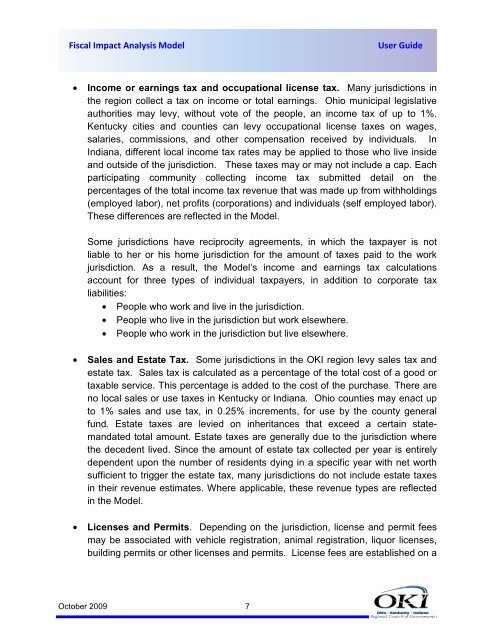FIAM USER GUIDE COVER II - Fiscal Impact Analysis Model - OKI
FIAM USER GUIDE COVER II - Fiscal Impact Analysis Model - OKI
FIAM USER GUIDE COVER II - Fiscal Impact Analysis Model - OKI
You also want an ePaper? Increase the reach of your titles
YUMPU automatically turns print PDFs into web optimized ePapers that Google loves.
<strong>Fiscal</strong> <strong>Impact</strong> <strong>Analysis</strong> <strong>Model</strong><br />
User Guide<br />
• Income or earnings tax and occupational license tax. Many jurisdictions in<br />
the region collect a tax on income or total earnings. Ohio municipal legislative<br />
authorities may levy, without vote of the people, an income tax of up to 1%.<br />
Kentucky cities and counties can levy occupational license taxes on wages,<br />
salaries, commissions, and other compensation received by individuals. In<br />
Indiana, different local income tax rates may be applied to those who live inside<br />
and outside of the jurisdiction. These taxes may or may not include a cap. Each<br />
participating community collecting income tax submitted detail on the<br />
percentages of the total income tax revenue that was made up from withholdings<br />
(employed labor), net profits (corporations) and individuals (self employed labor).<br />
These differences are reflected in the <strong>Model</strong>.<br />
Some jurisdictions have reciprocity agreements, in which the taxpayer is not<br />
liable to her or his home jurisdiction for the amount of taxes paid to the work<br />
jurisdiction. As a result, the <strong>Model</strong>’s income and earnings tax calculations<br />
account for three types of individual taxpayers, in addition to corporate tax<br />
liabilities:<br />
• People who work and live in the jurisdiction.<br />
• People who live in the jurisdiction but work elsewhere.<br />
• People who work in the jurisdiction but live elsewhere.<br />
• Sales and Estate Tax. Some jurisdictions in the <strong>OKI</strong> region levy sales tax and<br />
estate tax. Sales tax is calculated as a percentage of the total cost of a good or<br />
taxable service. This percentage is added to the cost of the purchase. There are<br />
no local sales or use taxes in Kentucky or Indiana. Ohio counties may enact up<br />
to 1% sales and use tax, in 0.25% increments, for use by the county general<br />
fund. Estate taxes are levied on inheritances that exceed a certain statemandated<br />
total amount. Estate taxes are generally due to the jurisdiction where<br />
the decedent lived. Since the amount of estate tax collected per year is entirely<br />
dependent upon the number of residents dying in a specific year with net worth<br />
sufficient to trigger the estate tax, many jurisdictions do not include estate taxes<br />
in their revenue estimates. Where applicable, these revenue types are reflected<br />
in the <strong>Model</strong>.<br />
• Licenses and Permits. Depending on the jurisdiction, license and permit fees<br />
may be associated with vehicle registration, animal registration, liquor licenses,<br />
building permits or other licenses and permits. License fees are established on a<br />
October 2009 7
















